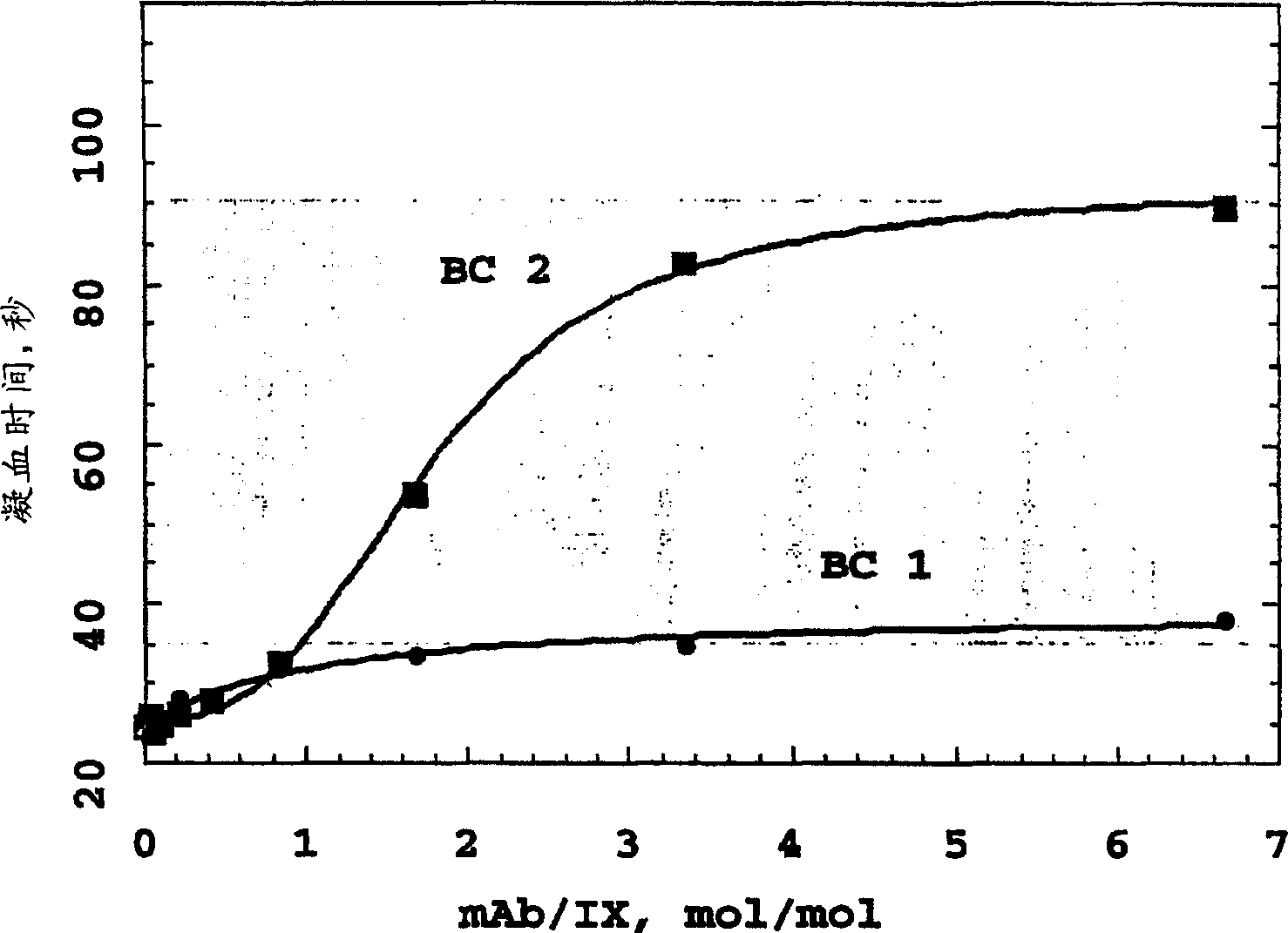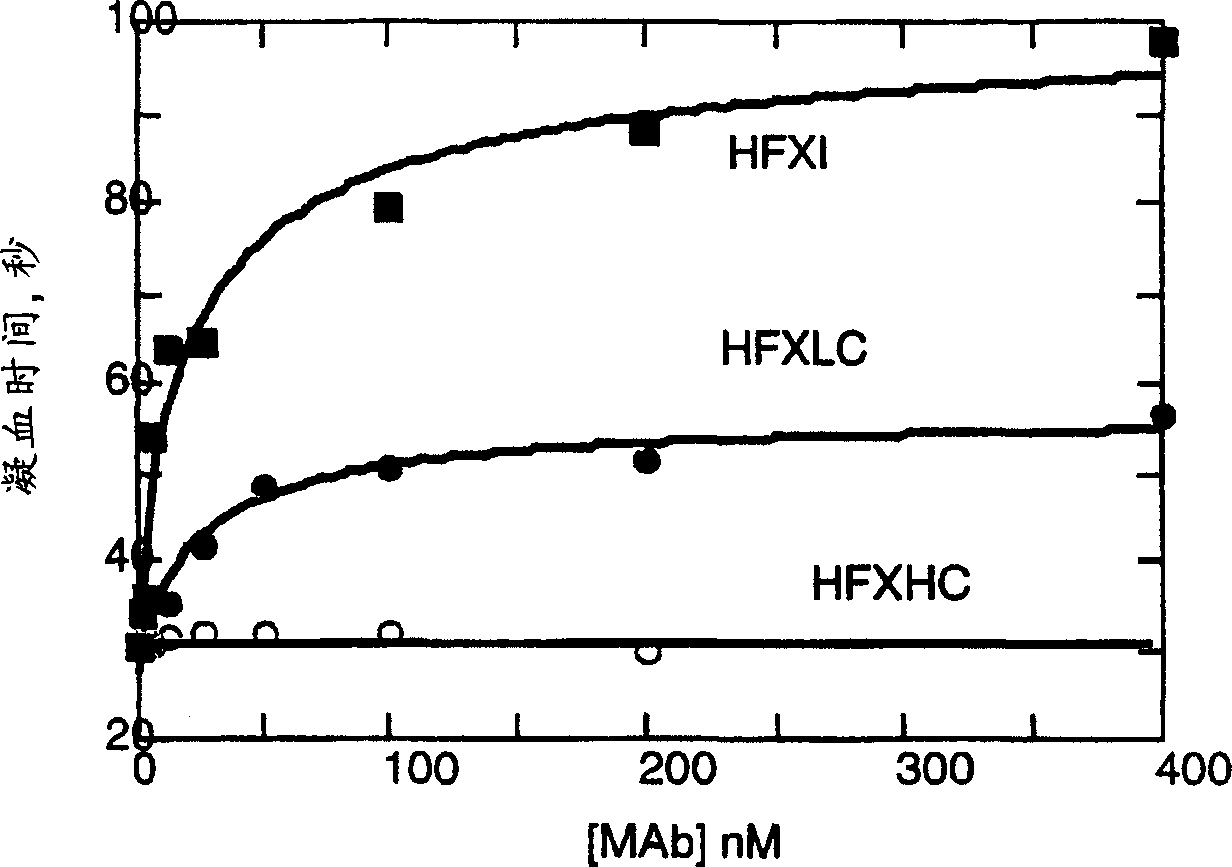Antithrombotic agents
A technique for thrombolytic agent and thromboembolism, applied in the field of monoclonal antibody and its use as a thrombosis inhibitor, can solve the problems of deterioration of ischemic injury and the like
- Summary
- Abstract
- Description
- Claims
- Application Information
AI Technical Summary
Problems solved by technology
Method used
Image
Examples
Embodiment 1
[0130] Preparation and Screening of Anti-Factor IX Monoclonal Antibodies
[0131] Female Balb / C mice were injected with human factor IX purified as described by Jenny, R. et al., Prep Biochem, 16, 227-245 (1986). Typically, each mouse receives an initial injection of 1000 g of protein dissolved in 0.15 mL of phosphate-buffered saline (PBS) mixed with 0.15 mL of complete Freund's adjuvant. During 2-3 months, 500 g of protein dissolved in 0.15 mL of PBS and 0.15 mL of incomplete Freund's adjuvant was injected every two weeks for booster immunization. After the last booster injection, mice received 3 days before spleen / myeloma cell fusion 500 g of Factor IX in PBS. Splenocytes were isolated from immunized mice and followed by Oi, V.T. et al. in "Selected Methods in Cellular Immunology," Mishell, B.B. and Shigii, S.M., eds., Freeman Press, San Francisco A method described in a book, using polyethylene glycol to fuse spleen cells with NS-1 myeloma cells (Kohler, G. et al., Eur J...
Embodiment 2
[0135] Self-limiting role of anti-coagulation factor antibodies in blood coagulation
[0136] The effect of increasing anti-coagulation factor antibody concentrations on human plasma activation was determined in a fibrometer (Becton-Dickinson Microbiology Systems, Cockeysville, Maryland) using the Baxter reference program LIB0293-J, version 3 / 93 (Baxter Scientific, Edison, New Jersey). Effect of partial thromboplastin time (aPTT).
[0137] Before starting this test, filled with 2 ~ 3mL 0.02M CaCl 2 Put the 5mL test tube into the heating chamber of the fibrometer. Human plasma samples were obtained either from freshly collected blood stored in an ice bath or reconstituted by Hemostasis Reference Plasma (American Diagnostics, Greenwich, Connecticut) according to the manufacturer's instructions.
[0138] Unfractionated heparin from porcine intestinal mucosa (Sigma Chemical, St.Louis, Missouri), low molecular weight heparin from intestinal mucosa (Lovenox®, enoxaparin sodium, ...
Embodiment 3
[0160] Efficacy of murine factor IX mAbs in rat thrombus model
[0161] To evaluate the efficacy of anti-factor IX antibodies in preventing arterial thrombosis, the rat carotid artery thrombosis model reported by Schumacher et al., J Cardio Pharm, 22, 526-533 (1993) was used. The model is constructed as follows: FeCl 3 Oxygen radicals generated by the solution are applied on the surface of the carotid artery causing segmental damage to the carotid endothelium.
[0162] Briefly, rats were anesthetized with sodium pentobarbital, the jugular vein cannulated for intravenous injection, and the left femoral artery was cannulated for blood pressure and heart rate monitoring. The carotid artery was aseptically isolated through a surgical incision in the neck and equipped with a magnetic flow probe to measure blood flow. After a period of stabilization, baseline parameters were established for the following variables: carotid blood flow, arterial pressure, heart rate, activated par...
PUM
 Login to View More
Login to View More Abstract
Description
Claims
Application Information
 Login to View More
Login to View More - R&D
- Intellectual Property
- Life Sciences
- Materials
- Tech Scout
- Unparalleled Data Quality
- Higher Quality Content
- 60% Fewer Hallucinations
Browse by: Latest US Patents, China's latest patents, Technical Efficacy Thesaurus, Application Domain, Technology Topic, Popular Technical Reports.
© 2025 PatSnap. All rights reserved.Legal|Privacy policy|Modern Slavery Act Transparency Statement|Sitemap|About US| Contact US: help@patsnap.com



